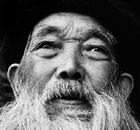Society
Fallen foreign heroes not forgotten
(China Daily)
Updated: 2010-04-02 07:05
 |
Large Medium Small |
Call to protect memory of brave pilots

American pilots and Chinese soldiers killed in battle against the invading Japanese airforce during World War II were buried in the woods of Puzhao village, Yunnan province, more than half a century ago. However, their tombs were virtually undiscovered until 2007, when the Yunnan Flying Tigers Research Institution found them by following clues included in The Aluminum Trail, a book written in 1989 by Chick Marrs Quinn.
About 300 pilots with the Fei Hu, or "Flying Tigers" - the nickname given to the 1st American Volunteer Group of the Chinese Air Force - and 500 Chinese soldiers are buried at the site, which was built beside a nunnery in 1943 in the northeastern suburbs of Kunming, the provincial capital, said Sun Guansheng, chairman of the institution.
The tombs were "lost" when they were moved to make way for a storehouse either in the late 1940s or early 1950s, and since then, the memorial has not been properly protected, experts say .
"Some of the graves have been robbed and some have sunken," said Sun. "Many tombstones carrying names of the dead pilots and soldiers were even used to build a reservoir in the 1950s. Exposed to the wind and the rain, what is left of the Flying Tigers cemetery is bleak."
"We are calling on the authorities to take measures to effectively protect this vital and historic site."
The tombs in Puzhao are about 4 km from Wujiaba Airport, the former air base of the Flying Tigers, most of whose names have since been forgotten.
The group, which was led by United States General Claire L. Chennault, was formed on Aug 1, 1941, to help China fight off invading Japanese troops and later absorbed into the US Air Force 23 Fighter Group, part of 14th Air Force. Their planes were recognizable for the shark's teeth painted on the nose, while the pilots were revered for their courage and skill in battle.
Many Chinese now call all US pilots who flew with the 14th Air Force in World War II "Flying Tigers".
Li Shan, a Kunming resident who read about the tombs, took her 7-year-old son to see the cemetery as she wants him to learn more about the history.
"We've now put a tombstone in the graveyard for people who come and pay their respects, but we should build a better cemetery to honor those who helped us during the war," said Sun.
Author still a big hit on campus
Ask any student on Peking University's campus in Beijing where to find the tomb of Edgar Snow (1905-1972) and nine out of 10 will not only point you in the right direction, but also probably give you a brief history lesson on the life and works of the prominent American journalist.
Born in Kansas City, Missouri, the scribe and former teacher at the university is best remembered for his book Red Star Over China, which introduced the Chinese Communist movement in early 1920s to late 1930s to domestic and overseas readers. He was also the first Western journalist to interview China's former leader Mao Zedong.
"I know every year there will be a few essays about him written by our students," said Sun Hua, director of the university's Chinese center for Edgar Snow studies. "Some seniors also made a documentary film about him."
Following his death in Geneva, Switzerland, half of Snow's ashes were flown to China. The original plan was to bury them in Babaoshan Revolutionary Cemetery in Beijing, which is reserved for national heroes. "However, his family thought it was better to have his tomb on campus because he loved to hang out with young Chinese people," said Sun.
The site of his tomb, which is on a slope south of the university's Weiming Lake, is close to the recently renovated Tan Siu Lin center for international studies, where Snow taught journalism in the early 1930s. His tombstone reads "Edgar Snow, American friend of the Chinese people" in English and Chinese.
"He is a reporter with a conscience. He deserves a Pulitzer prize," said Li Yuming, 29, a Beijing legal professional who visited the writer's tomb after reading his works. "When I went to his tomb, no one was there, just a bunch of dried flowers. It's a desolate scene but I think people like Snow are still remembered."
She is right. Apart from the Chinese center for Edgar Snow studies, the author continues to be an inspiration to students and scholars nationwide.
"For the post-1980s generation, the history in his book does not exist in our memory," Yan Lu, a 26-year-old journalist with the Liuyang Daily in Hunan province, wrote on her blog after finishing Red Star Over China for an assignment. "If (Chinese) students can read news stories like these, instead of struggling to memorize the textbooks without emotion or even meaning, they would have more passion and respect for earlier generations."
"Snow knew nothing before he met Chairman Mao and the Red Army, just like we know nothing about the past. But we learn."
Wife carries on doctor's good work
For Zhou Sufei, Tomb-sweeping Day marks just one of the 365 days a year she spends honoring her husband, George Hatem (1910-1988), the legendary American doctor who worked for more than five decades to rid China of leprosy and venereal diseases.
Zhou, 91, has been running the Ma Haide Foundation since 1988 and every year distributes 20 awards - with a cash prize of 5,000 yuan ($700) - to people who have made a contribution to the treatment for leprosy.
"We usually give out the money before the Chinese New Year. It's not a lot of money, but for those winners who are doctors and nurses in the rural areas, this money could be very helpful," she said.
Born in Buffalo, New York, Hatem (his Chinese name was Ma Haide) was the first foreigner granted Chinese citizenship in 1949 after the founding of the People's Republic of China and was also made a public health official by the Communist Party of China.
His tomb is among those of famous artists, poets, musicians, soldiers and statesmen interred at Babaoshan Revolutionary Cemetery in Beijing's Shijingshan district.
On Monday, Zhou is planning to make her annual trip to sweep her husband's tomb. "It will just be family members," she said. "I take two flower baskets to his tomb with my son, grandson and daughter-in-law every year. My son is quite busy these days, so we have to wait for him. And there will probably be traffic jams on Tomb-sweeping Day, so we might go there in the afternoon."
Hatem provided most of the Ma Haide Foundation's funds before his death but the group now relies on donations from within China and overseas. However, with the depreciation of the United States dollar and the lowering of interest rates in recent years, "it has become harder for the foundation to get involved with charity projects", said Zhou.
Although she is worried about the future of the foundation, she has no fears about her husband's legacy being remembered.
"When I go to my husband's tomb, there are always flowers beside it," she said. "We have no idea where most come from. It might be his old friends, or families of his former patients."







